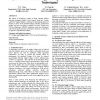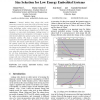419 search results - page 4 / 84 » Impact of Technology Scaling in the Clock System Power |
ASPLOS
2004
ACM
14 years 4 months ago
2004
ACM
Power density in high-performance processors continues to increase with technology generations as scaling of current, clock speed, and device density outpaces the downscaling of s...
ISVLSI
2006
IEEE
14 years 5 months ago
2006
IEEE
This paper investigates the performance and power dissipation of Globally Asynchronous Locally Synchronous (GALS) multi-processor systems. We show that communication loops are a s...
ISCAS
2007
IEEE
14 years 5 months ago
2007
IEEE
— A methodology based on supply voltage optimization for lowering the power consumption and temperature fluctuations induced skew of clock distribution networks is proposed in th...
DAC
2003
ACM
15 years 3 days ago
2003
ACM
The impact of technology scaling on three run-time leakage reduction techniques (Input Vector Control, Body Bias Control and Power Supply Gating) is evaluated by determining limit...
CSREAESA
2007
14 years 18 days ago
2007
- Several studies have shown that cache memories account for more than 40% of the total energy consumed in processor-based embedded systems. In microscale technology nodes, active ...


